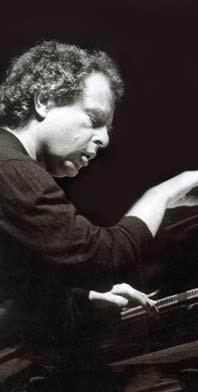
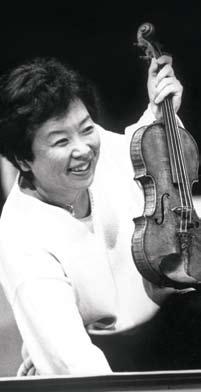
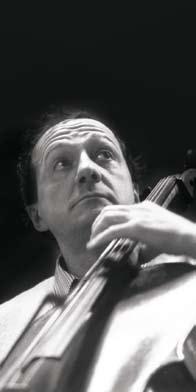
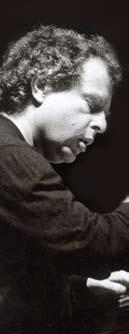

28.2.2008
香港大會堂音樂廳
Concert Hall
Hong Kong City Hall
演出長約1小時45分鐘,包括一節15分鐘
中場休息
Running time: approximately 1 hour and 45 minutes with a 15 minute interval
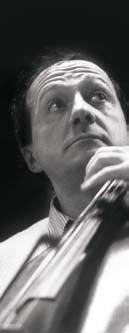
Biographies
Yuuko Shiokawa 10 美克羅斯.佩仁伊
Miklós Perényi 13 曲目 Programme
樂曲介紹 Programme Notes
貝多芬 Beethoven 15 C小調三重奏,作品1,第3首
Trio in C minor, Op 1, No 3 17 D大調三重奏,作品70,第1首,《鬼魅》
Trio in D major, Op 70, No 1, Ghost 18 降B大調三重奏,作品97,《大公爵》
Trio in B flat major, Op 97, The Archduke
為了讓大家對這次演出留下美好的印象,請切記在節目開始前關掉手錶、 無綫電話及傳呼機的響鬧裝置。會場內請勿擅自攝影、錄音或錄影,亦不 可飲食和吸煙,多謝合作。
To make this performance a pleasant experience for the artists and other members of the audience, PLEASE switch off your alarm watches, MOBILE PHONES and PAGERS. Eating and drinking, unauthorised photography and audio or video recording are forbidden in the auditorium. Thank you for your co-operation.

ANDRÁS Schiff
安德拉斯.席夫
鋼琴 Piano
安德拉斯.席夫 1953 年生於匈牙利布
達佩斯,五歲習琴,師從伊麗莎白.沃 道斯,後考進李斯特音樂學院,師從 帕爾.卡杜沙教授、哥爾格.庫塔克和 費倫茨.勞多斯;在倫敦期間則師從喬 治.馬爾科姆。
席夫的演奏以獨奏會和專題音樂會系列 為主,曲目包括巴赫、海頓、莫扎特、
András Schiff was born in Budapest, Hungary, in 1953, and started piano lessons at the age of five with Elisabeth Vadasz. He continued his musical studies at the Ferenc Liszt Academy with Professor Pál Kadosa, György Kurtág and Ferenc Rados and in London with George Malcolm.
Recitals and special cycles, in the major keyboard works of J S Bach, Haydn, Mozart, Beethoven, Schubert, Chopin, Schumann and Bartók, form an
貝多芬、舒伯特、蕭邦、舒曼和巴托克 的鍵盤作品。2004年起,他開始演出一
系列貝多芬專題音樂會,按寫作時序演 出貝多芬 32 首鋼琴奏鳴曲,並在瑞士蘇 黎世音樂廳現場錄音。
席夫過去曾與多個譽滿國際的樂團和指 揮合作,現在則主要以指揮和獨奏者身 份演出。1999年他創辦了安德烈.巴爾
卡教堂室樂團;此外,他每年都會與倫 敦愛樂樂團及歐洲室樂團合作。
1989 至 1998 年,席夫出任在薩爾茨堡 附近月湖舉辦的樂聚室樂音樂節藝術總 監;1995年,他與海恩茨.霍利格在瑞 士卡爾特修道院創辦了聖靈降臨節音樂 節;1998年,席夫以「向建築大師帕拉 迪歐致敬」為題,在維琴察奧林匹克劇 院舉辦同類音樂會系列; 2004 至 2007 年間他出任威瑪藝術節常駐藝術家。
席夫曾獲殊榮多不勝數,包括巴托克獎 ( 1991 )、克勞迪奧.阿勞紀念獎(杜塞
多夫舒曼學會頒發, 1994 )、科蘇特獎 (匈牙利最高榮譽獎, 1996 )、金帕拉 迪歐獎(維琴察市頒發)、不來梅音樂
節獎(頒予在國際上有傑出藝術成就的 音樂家, 2003 ), 2006 年更成為波恩 「貝多芬故居」榮譽成員。
2007年,席夫展開了一項有關莫扎特的 大型計劃,此後數年,他會參與編輯新 版莫扎特鋼琴協奏曲,為原有的鋼琴聲 部編上指法,並在原作沒有華彩樂段的 地方補上華彩樂段。此外,席夫將為巴 赫兩冊《十二平均律鍵盤曲集》( Henle 原典版)新版本編上指法。
席夫獲布達佩斯、代特莫爾德和慕尼黑 三地的音樂學院委任為榮譽教授。
important part of Schiff’s activities. In 2004 he began performing a complete cycle of the 32 Beethoven Piano Sonatas in chronological order, recording them live at the Tonhalle, Zürich, Switzerland.
András Schiff has worked with most of the major international orchestras and conductors, but nowadays performs mainly as a conductor and soloist. In 1999 he created his own chamber orchestra — the Cappella Andrea Barca. In addition, he works each year with the Philharmonia Orchestra London and the Chamber Orchestra of Europe.
From 1989 until 1998 Schiff was artistic director of the Musiktage Mondsee chamber music festival near Salzburg. In 1995 together with Heinz Holliger, he founded the Ittinger Pfingstkonzerte in Kartause Ittingen, Switzerland. In 1998 Schiff started a similar series, entitled Hommage to Palladio, at the Teatro Olimpico di Vicenza and between 2004 and 2007 he was artist in residence of the Kunstfest Weimar.
Among other high distinctions, Schiff was awarded the Bartók Prize in 1991; the Claudio Arrau Memorial Medal from the Robert Schumann Society, Düsseldorf in 1994; the Kossuth Prize, the highest Hungarian honour in 1996; the Palladio d’Oro by the City of Vicenza, and the Musikfest-Preis Bremen (for outstanding international artistic achievement) in 2003. In June 2006 he became an Honorary Member of the Beethoven House in Bonn.
In 2007 Schiff began an important Mozart project. Over the next few years he will work on an edition of Mozart’s Piano Concertos, contributing fingerings to the original piano parts and adding cadenzas where the original cadenzas are missing. In addition, both volumes of Bach’s Well-Tempered Klavier will be reprinted in the Henle original texts, with fingerings by Schiff.
András Schiff has been made an honorary Professor by the Music Schools in Budapest, Detmold and Munich.

YUUKO Shiokawa
塩川悠子
小提琴 Violin
塩川悠子生於東京,五歲習小提琴,先
在利馬隨尤金.克林瑪學藝,後負笈慕 尼黑,師隨威廉.史特羅斯教授,1961
年完成高級課程;再隨桑多爾.維格教
授深造, 1968 年學成; 19 歲時贏得孟 德爾頌獎及德國音樂學院大賽首獎。
塩川悠子曾與多個知名樂團合作,包 括柏林愛樂樂團(在柏林、薩爾茨堡和
Born in Tokyo, Yuuko Shiokawa began her violin studies at the age of five. She first studied with Eugen Cremer in Lima and then completed advanced studies with Professor Wilhelm Stross in Munich in 1961, and Professor Sandor Vegh in 1968. At the age of 19 she won the Mendelssohn Prize and First Prize in the Competition of German Music Conservatories. Her orchestral engagements have included concerts with the Berlin Philharmonic in Berlin, Salzburg and
日本演出,卡拉揚指揮)、以色列愛樂 樂團、巴伐利亞電台樂團(庫比利克指
揮,曲目之一是揚.庫比利克第六小提 琴協奏曲;曾與倫敦交響樂團合作過同 一樂曲,另外也曾在琉森藝術節演出 過)。塩川悠子也曾與紐約愛樂樂團、 波士頓交響樂團和匹茲堡交響樂團一起 演出。
此外,塩川悠子曾與布魯諾.卡尼諾合 作,於慕尼黑演出一系列莫扎特鋼琴及 小提琴奏鳴曲音樂會,其後在倫敦威格 摩爾音樂廳的演出則夥拍席夫;1988年 及1991年分別參與威格摩爾音樂廳兩個 備受推崇的音樂節 海頓音樂節和巴 托克 / 貝多芬音樂節; 1994 年又在巴比 肯音樂廳的舒伯特 / 亞納切克音樂會系 列演出。
她除了定期與席夫演出二重奏,也會與 席夫、帕格曼舒科夫或佩仁伊合作三重 奏演出。塩川悠子參與過的音樂節包括 愛丁堡、琉森、洛肯豪斯、薩爾茨堡、 月湖鎮、利奇菲爾德和萬寶路;也會定 期回日本參與各種音樂活動。
塩川悠子灌錄過多張唱片,曾以莫扎 特用過的小提琴,演奏莫扎特作品,包 括小提琴奏鳴曲選(與席夫合作)、鋼 琴四重奏(與席夫、賀巴特和佩仁伊合 作)、鋼琴三重奏(與席夫和佩仁伊合 作)。除了莫扎特的作品,塩川悠子與 席夫、佩仁伊三人也灌錄了舒伯特鋼琴 三重奏及舒伯特C大調《幻想曲》。
Japan (with Karajan); Israel Philharmonic; Bavarian Radio Orchestra under Rafael Kubelik including performances of Jan Kubelik’s Violin Concerto No 6, a work which she has also performed with the London Symphony Orchestra and at the Lucerne Festival. In the US she has worked with the New York Philharmonic, the Boston Symphony and the Pittsburgh Symphony.
Other engagements have included a cycle of Mozart piano and violin sonatas with Bruno Canino in Munich, and with András Schiff at the Wigmore Hall in London. In 1988 she participated in the Wigmore Hall’s highly acclaimed Haydn Festival, and their Bartók/Beethoven Festival in 1991. She also took part in the Schubert/Janáćek series at the Barbican in 1994.
In addition to giving regular duo recitals with Schiff, she also performs in trios with Schiff and either Boris Pergamenschikow or Miklós Perényi. Festivals in which she has appeared include: Edinburgh, Lucerne, Lockenhaus, Salzburg, Mondsee, Lichfield and Marlboro. She returns regularly to Japan for various engagements.
Shiokawa’s recordings include several from the Mozart repertoire, using Mozart’s original violin; a selection of Violin Sonatas with András Schiff; the Piano Quartets with Schiff, Erich Hobarth and Miklós Perényi and Piano Trios with Schiff and Perényi. With Schiff and Perényi she has recorded the Schubert Piano Trios and the Schubert Fantasie in C major.

MIKLÓS Perényi
佩仁伊生於布達佩斯一個音樂世家,五
歲起隨美克羅斯.森波奇(師承大衛. 朴帕)學習大提琴;七歲考進布達佩斯 李斯特音樂學院,師隨艾德.班達教 授;九歲在布達佩斯首演;後負笈羅馬 聖西西莉亞音樂學院深造,師隨恩利 科.麥納爾迪教授。
大提琴 Cello
Miklós Perényi was born in Budapest into a musical family. At the age of five he received his first cello lesson from Miklós Zsamboki, a former pupil of David Popper, and at the age of seven he was admitted to the Ferenc Liszt Music Academy Budapest where he studied with Professor Ede Banda. He made his debut in Budapest at the age of nine and went on
佩仁伊1962年於布達佩斯卡薩爾斯國際 大賽獲獎; 1965 和 1966 年,帕布路. 卡薩爾斯在策馬特和波多黎各舉行大師 班,佩仁伊均獲邀參與;隨後佩仁伊更 連續四年於萬寶路音樂節中演出。
佩仁伊1974年起任教於布達佩斯李斯特 音樂學院,1980年出任該學院大提琴系 教授。
1980 年及 1987 年,佩仁伊分別獲頒科 蘇特獎和巴托克-帕斯托莉獎,以肯定他 的音樂成就。
佩仁伊是歐美、日本和中國各音樂重鎮 和音樂節常客,擔任獨奏和演奏室樂作 品。他曲目廣泛,上起十七、十八世紀 作品,下及當代音樂。
佩仁伊也是作曲家,除了大提琴樂曲, 也為不同規模的室樂團創作音樂。
除了經常與凱勒四重奏合作,佩仁伊也 定期與席夫攜手演出。兩人最近灌錄的 貝多芬大提琴與鋼琴奏鳴曲大獲好評, 並獲頒2005年康城古典唱片獎。
futher his studies at the Accademia Santa Cecilia Roma with Professor Enrico Mainardi.
In 1962 Perényi was a prize winner at the International Casals Competition held in Budapest. In 1965 and 1966 Pablo Casals invited him to join his masterclasses in Zermatt and Puerto Rico, and then to perform at the Marlboro Festival, which he did for four consecutive years.
In 1974 Perényi began teaching at the Ferenc Liszt Music Academy Budapest, and since 1980 has been Professor of the cello department.
As an acknowledgement of his musical activities Perényi was awarded the Kossuth Prize in 1980 and the Bartók-Pasztory Prize in 1987. As a soloist and a chamber musician he has appeared in many musical centres and festivals in Europe as well as the US, Japan and China. He has a very extensive repertoire, including pieces from the 17th and 18th centuries, and works from the present day.
Perényi is also a composer; his compositions include pieces for cello and works for small and large chamber ensembles.
In addition to working frequently with the Keller Quartet, he also performs regularly with András Schiff — with whom he has recently recorded the Beethoven Sonatas for cello and piano. The CD received outstanding reviews and was awarded the Cannes Classical Award in 2005.
貝多芬 (1770–1827) C小調三重奏,作品1,第3首
生氣勃勃的快板
如歌的行板及變奏
小步舞曲:接近快板及三聲中段
終曲:極急板
D大調三重奏,作品70,第1首,《鬼魅》
生氣勃勃的快板
富感情的極緩板
急板 – 中場休息 –
降B大調三重奏,作品97,《大公爵》
中庸的快板
諧謔曲:快板及三聲中段
如歌但流暢的行板
中庸的快板
Ludwig van Beethoven
Trio in C minor, Op 1, No 3 (1770–1827)
Allegro con brio
Andante cantabile con Variazioni
Menuetto: Quasi allegro & Trio
Finale: Prestissimo
Trio in D major, Op 70, No 1, Ghost
Allegro vivace e con brio
Largo assai ed espressivo
Presto
Interval –
Trio in B flat major, Op 97, The Archduke
Allegro moderato
Scherzo: Allegro & Trio
Andante cantabile ma pero con moto
Allegro moderato
